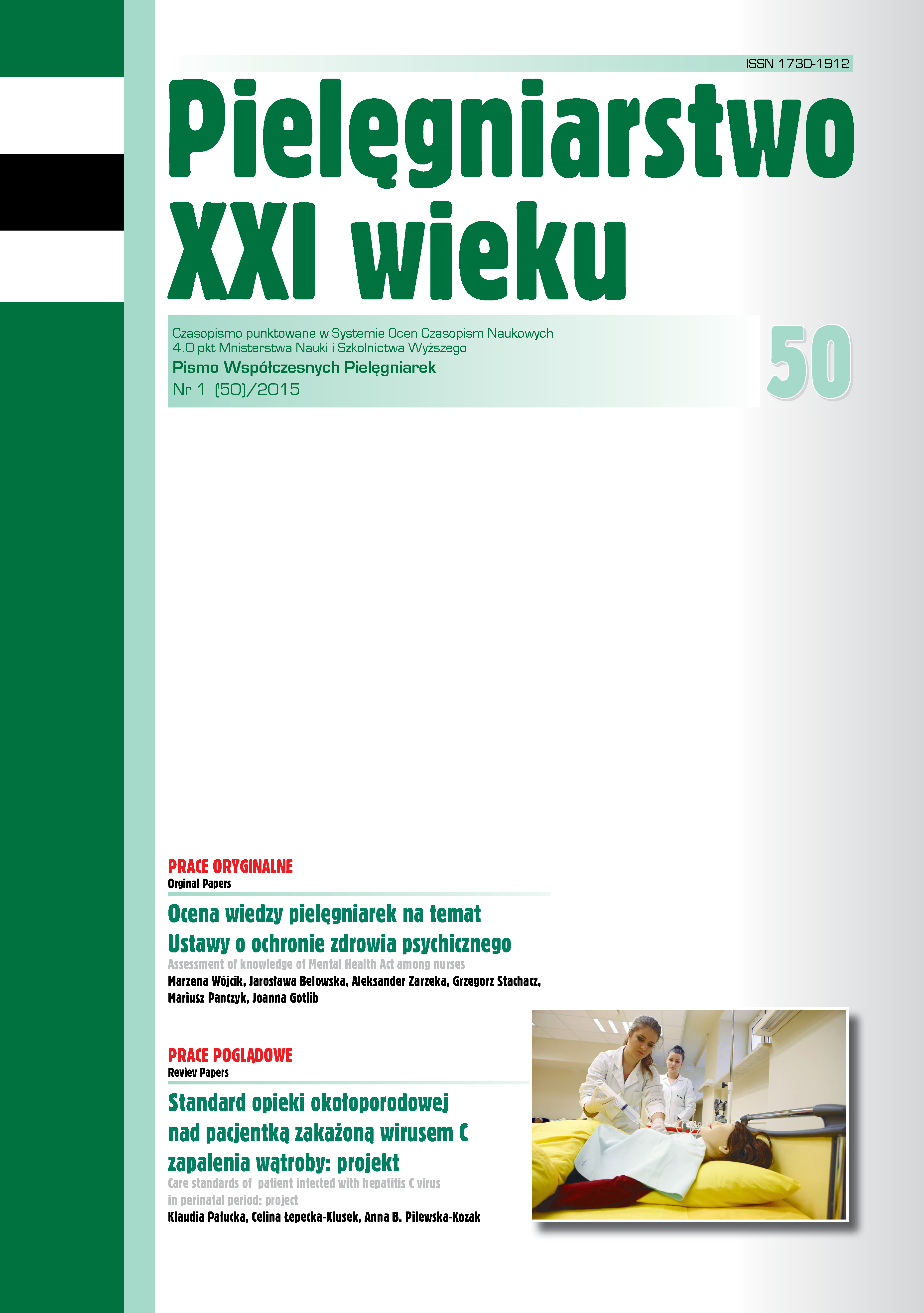Postępowanie Zespołów Ratownictwa Medycznego z pacjentem w materiale Wojewódzkiego Pogotowia Ratunkowego SP ZOZ w Lublinie
DOI:
https://doi.org/10.12923/p21w-2015-1/02Słowa kluczowe:
medycyna ratunkowa, Zespół Ratownictwa Medycznego, kwalifikowana pierwsza pomocAbstrakt
ACTIVITIES OF MEDICAL EMERGENCY TEAMS WITH THE PATIENTS IN THE MATERIAL OF REGIONAL DIRECTORATE OF EMERGENCY MEDICAL SERVICES IN LUBLIN
Wprowadzenie. Zespoły Ratownictwa Medycznego (ZRM) są jednostkami Systemu Ratownictwa Medycznego, które odpowiadają za podjęcie medycznych czynności ratunkowych na miejscu zdarzenia.
Cel pracy. Celem pracy była ocena postępowania Zespołów Ratownictwa Medycznego z pacjentem oraz analiza wpływu typu ZRM, trybu wyjazdu, lidera ZRM, miejsca zdarzenia, podstacji, rozpoznania ogólnego i szczegółowego na postępowanie Zespołów Ratownictwa Medycznego.
Materiał i metoda. Metodą badawczą wykorzystaną w pracy była retrospektywna analiza dokumentacji medycznej specjalistycznych i podstawowych Zespołów Ratownictwa Medycznego. Analizą objęto łącznie 1624 interwencje ZRM, które miały miejsce w pierwszym tygodniu każdego kwartału 2009 roku.
Wyniki. Specjalistyczne ZRM częściej niż podstawowe ZRM udzielały pomocy na miejscu zdarzenia, a następnie transportowały pacjenta do szpitala. Interwencje w trybie alarmowym częściej niż interwencje w trybie pilnym i zwykłym wiązały się z koniecznością udzielenia pomocy na miejscu zdarzenia, a następnie transportu poszkodowanego do szpitala. Lekarze częściej niż pielęgniarki i ratownicy medyczni udzielali pomocy na miejscu zdarzenia, a następnie transportowali pacjenta do szpitala. Pielęgniarki zdecydowanie rzadziej niż ratownicy medyczni i lekarze decydowały się na udzielenie pomocy wyłącznie na miejscu zdarzenia. Podczas interwencji ZRM poza miastem pacjentom częściej udzielano pomocy wyłącznie na miejscu zdarzenia niż podczas interwencji w mieście. Pacjentom z rozpoznaniem urazów i zatruć rzadziej niż z rozpoznaniem zachorowania udzielano pomocy wyłącznie na miejscu, częściej natomiast podejmowano interwencję na miejscu zdarzenia a następnie transportowano do szpitala.
Wnioski. Na postępowanie ZRM z pacjentem istotny statystycznie wpływ ma szereg zmiennych: typ ZRM, tryb wyjazdu ZRM, zawód kierownika ZRM, miejsce zdarzenia oraz przyczyna wezwania ZRM.
Bibliografia
1. Ustawa z dnia 8 września 2006 r. o Państwowym Ratownictwie Medycznym. Dz. U. 2006 r. nr 191, poz. 1410 (http://isip.sejm.gov.pl/DetailsServlet?id=WDU20061911410).
2. Brongel L, Drab E. Złota godzina – okres przedszpitalny. [w:] Brongel L, red. Złota godzina – czas życia, czas śmierci. Kraków: Wydawnictwo Medyczne; 2007: 59-78.
3. Gaszyński W. Zadania lekarza zespołu ratunkowego na miejscu zdarzenia; [w:] Gaszyński W, red. Intensywna terapia i wybrane zagadnienia medycyny ratunkowej. Warszawa: Wydawnictwo Lekarskie PZWL; 2008: 113-137.
4. Karski J, Nogalski A. Zasady organizacji struktur medycyny ratunkowej, [w:] Zawadzki A, red. Medycyna ratunkowa i katastrof. Warszawa: Wydawnictwo Lekarskie PZWL; 2006: 349-368.
5. Gaszyński W. „S” i „P”, czyli karetki po nowemu. Anestezjol. Rat. 2007; 2: 65-69.
6. Dick WF. Anglo – American vs. Franco – German emergency medical services system. Prehosp Disaster Med. 2003; 18: 29-35.
7. Trzos A. Lekarz ratunkowy czy ratownik medyczny? Rola i zadania w nowoczesnym systemie ratownictwa przedszpitalnego. [w:] Konieczny J red. Ratownik medyczny – problemy edukacyjne i organizacyjno – prawne. Monografia. Inowrocław – Poznań: Oficyna Wydawnicza Garmond; 2006: 169-173.
8. Hladki W, Andres J, Trybus M et al. Emergency medicine in Poland. Resuscitation. 2007; 75(2): 213-218.
9. Jakubaszko J: System organizacyjny ratownictwa medycznego w Polsce. Przypis redaktora naukowego, [w:] Plantz SH, Wipfler III EJ, red. wyd. II pol. Jakubaszko J, red. Medycyna ratunkowa. Wrocław: Elsevier Urban&Partner; 2009: 834-835.
10. Hupert Z, Horoch A, Istelska-Michalik A. Monitorowanie 11 celu operacyjnego Narodowego Programu Zdrowia – stan obecny, perspektywy, zagrożenia. Zdr. Publ. 2001; 111(3): 159-162 (http://www.zdrowiepubliczne.pl/artykul/szczegoly/id/923).
11. Hupert Z, Schabowski J, Szulc A. Ocena realizacji 11 Celu Operacyjnego Narodowego Programu Zdrowia w latach 1998-2003. Zdr. Publ. 2005; 115(1): 110-114 (http://www. zdrowiepubliczne.pl/artykul/szczegoly/id/1532).
12. Januszewski J. Ocena pomocy udzielonej w roku 2005 przez wybrany zespół reanimacyjny, Med. Intens. Rat. 2006; 9 (4): 313-317.
13. Kózka M, Kawalec E, Płaszewska – Żywko L. Analiza interwencji zespołów karetki pogotowia ratunkowego. Zdr. Publ. 2008; 118(1): 54-58 (http://www.zdrowiepubliczne. pl/artykul/szczegoly/id/2376).
14. Januszewski J. Mnogie obrażenia ciała w świetle danych z wyjazdów do wypadków zespołu specjalistycznego. Zdr. Publ. 2010; 120(3): 271-277 (http://www. zdrowiepubliczne.pl/artykul/szczegoly/id/2680).
15. Januszewski J. Pomoc medyczna udzielona ofiarom wypadków przez zespół reanimacyjny. Zdr. Publ. 2008; 118(1): 49-53 (http://www.zdrowiepubliczne.pl/artykul/ szczegoly/id/2375).
16. Guła P. Ratownictwo medyczne, podstawy organizacji i systemu. [w:] Guła P, red. Powiadamianie i dysponowanie w ratownictwie medycznym. Kraków: Wydawnictwo Medycyna Praktyczna; 2009: 11-42.
17. Aftyka A, Rudnicka – Drożak E, Rybojad B. A comparison of ambulance responses to incidents of Medical Emergency Teams led by nurses and paramedics – a retrospective single-center study. Int J Nurs Stud. 2014, (51): 555-561.
18. Sukumaran S, Henry JM, Beard D, et al. Prehospital trauma management: a national study of paramedic activities. Emerg Med J. 2005, 22 (1): 60-63.
Pobrania
Opublikowane
Numer
Dział
Licencja
Prawa autorskie (c) 2024 Anna Aftyka, Ewa Rudnicka-Drożak (Autor)

Utwór dostępny jest na licencji Creative Commons Uznanie autorstwa 4.0 Międzynarodowe.




